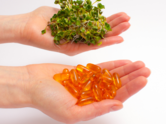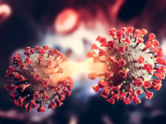01/9Oxford-AstraZeneca vaccine deemed "safe" for use, boosts immunity

Oxford-AstraZeneca announced the results of observatory data from phase I/II of their vaccine trial yesterday (July 20). The results have raised expectations that getting a vaccine before 2021 is possible. Owing to the crisis at large, AstraZeneca, the pharma company has already inked deals with several vaccine manufacturers globally to ramp up production of the novel vaccine. Phase III trials are underway as well, with one expected to start in India in the coming months.
02/9Key takeaways from Oxford-AstraZeneca's trial study


According to the study which has been published in The Lancet, the Oxford vaccine was able to spike up antibodies and create a "safe" immune response in the body, without causing any harm and delivering good results.
Not only is this the first-ever study to emerge out of the global vaccine race, but the observations may also be able to give medical scientists some idea about what works, what doesn't and how do we go about managing this novel vaccine in the new normal situation. Here are some takeaways from the efficacy data obtained from Oxford-AstraZeneca vaccine trials:
03/9What was the type of virus prototype being used?


SARS-COV2 is a novel virus, so different vaccine makers are developing a vaccine using different mutations and inactive vectors. Oxford researchers fashioned their prototype out of a harmless adenovector virus, which targets genetic mark-up in host cells to generate an immune response and ultimately, spike up production of antibodies against future infections. The same technology has been used by China-based Cansino Biologics, which again, has garnered "safe" and effective results leading up to phase III trials.
04/9How do viral vectors work?


Viral vectors, such as the ones made use by Oxford-AstraZeneca have been traditionally used to create a robust immune response. Viral vector vaccines use live viruses to carry DNA into human cells. The DNA contained in the virus encodes antigens that, once expressed in the infected human cells, elicit an immune response. In comparison to other technologies, viral vectors are also easier to use, increase immunity and focus on specific delivery of genes to target cells. Another easy benefit is that unlike some, they do not need to be stored in freezers, but simply refrigerator, which saves up on costs.
05/9How does it provide immunity against COVID-19?


According to the latest findings, volunteers administered a double dosage of the vaccine injection saw a spike up in a load of antibodies and achieved safe immunity, which was what experts were aiming at. While the number of people dosed with the vaccine are very less to register results, researchers say that the data nonetheless is encouraging. In a journal, researchers involved in the study mentioned that their vaccine, ChAdOx1 nCoV-19 "showed an acceptable safety profile, and homologous boosting increased antibody responses".
06/9Vaccine may push herd immunity faster


Early observations have also pointed out that the vaccine targeted the T-cell response. "We hope this means the immune system will remember the virus so that our vaccine will protect people for an extended period" read the study.
It was also seen that the strongest immunization was achieved in a group of 10 participants who received a double dose.
Researchers are hopeful that phase III trials, which are underway will see similar results and once done for, it can be then given the go-ahead for public use and inoculation.
07/9Are there any side-effects registered so far?


With any kind of vaccination, there always runs the risk of volunteers experiencing a host of symptoms and side-effects, which sometimes can mimic the infection itself. With Oxford-AstraZeneca data, it has been seen that 60% of the participants recorded little or mild side-effects post injection such as dizziness, headache, fever and light muscle pain. No other serious side-effects have been observed so far amongst the pool of healthy volunteers between the ages of 18-55.
08/9Can it work for everyone?


Phase I/II trials were done on a smaller batch of volunteers, in different phases, which involved healthy people between the ages of 18-55. High-risk patients, pregnant women and elderlies were not tested on. However, the vaccine developers did talk of a plan to enrol kids in one phase of their trial in June. Nonetheless, more research is needed before we reach this conclusion.
Phase III of the trial is the most crucial one, considering it involves a larger pool of participants and it will be easier to test out any side-effects, pros and cons.
Dosing is another issue which has been talked about. While a single and double dose registered different responses in volunteers, more research will be required for the same.
09/9How affordable would it be?


While talks of the vaccine's commercial availability have been often talked about (with many countries already signing deals), we don't know for sure as to how affordable or easily accessible Oxford-AstraZeneca, or any other vaccine contender in the race would be right now. There's a lot of data to be studied once phase III gets over with. Efforts will have to be made so that vaccine access is not inequitably granted, a problem which philanthropist Bill Gates and many other humanitarians are concerned about.
However, AstraZeneca has signed pacts with leading vaccine producers and pharma giants to ensure smooth and fast delivery of the vaccine doses if and when approvals are met. The company has promised to deliver up to a billion doses before the end of 2020. Serum Institue of India (SII), the firm's Indian partner is also starting work on the same and ensured that the vaccine will be economically priced to suit the needs of India and other developing nations.













































































































closecomments
SIGN IN WITH
GoogleEmail